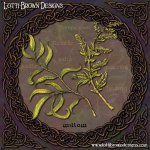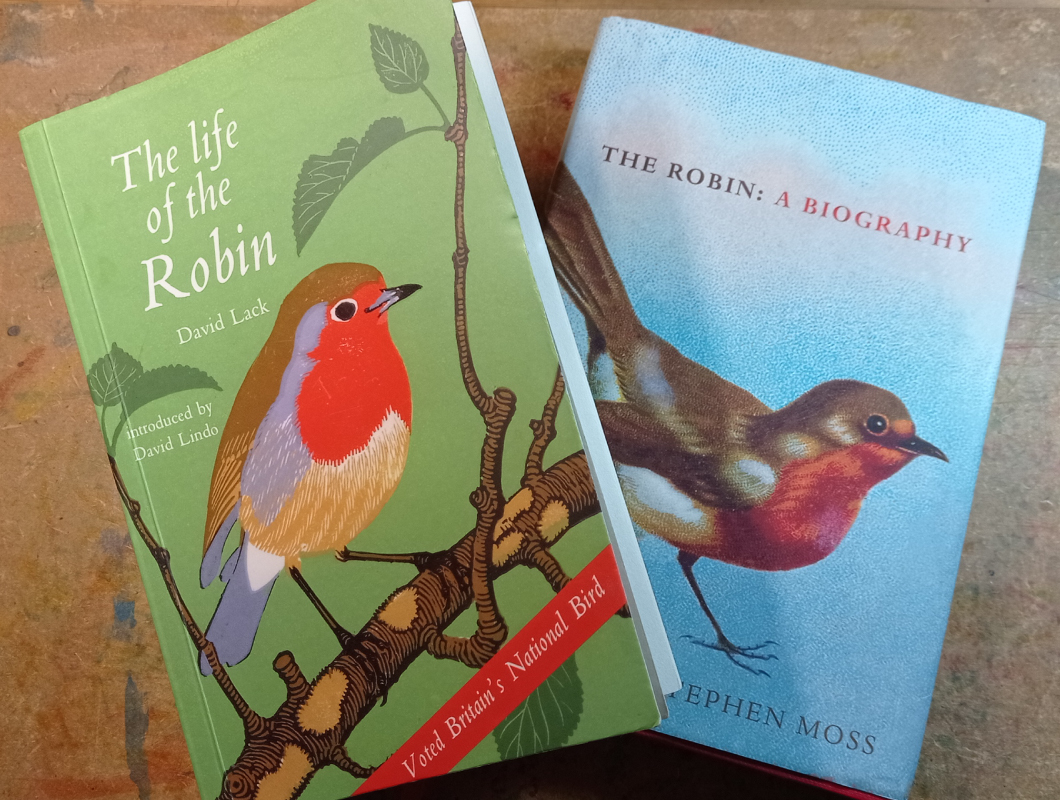SPRING 2025 - I've just completed a WEBSITE REVAMP! Everything is still here but may be in a slightly different place where than you left it and there's also lots of new sections, so if you're having trouble finding something in particular or you spot something that's not working as it should, please do get in touch and I'll do my best to help!

November Nature Journal
- Home
- Nature Journaling
- November Nature Journal
Explore my November nature journal pages with me and discover Autumn in East Yorkshire...
I hope that you will feel inspired to work on your own nature journal pages for this month.
I like to just have fun with my pages and use them to explore and record nature as I go about my daily walks and pottering around my small cottage garden - no perfect pages here, as I like to practice 'imperfect nature journaling' - journaling that's just for me (and hopefully to inspire you, too, of course), and that's just for fun and relaxation so that I can feel more connected to nature as that makes me feel happier and healthier.

Watch a flick-through of my nature journal pages for November just above - click play to start!
More info and a closer look at all the pages below...

November Nature Journal Pages
Come and browse through my November nature journal pages with me for a real taste of Autumn - with a few flowers surprisingly sprinkled through...
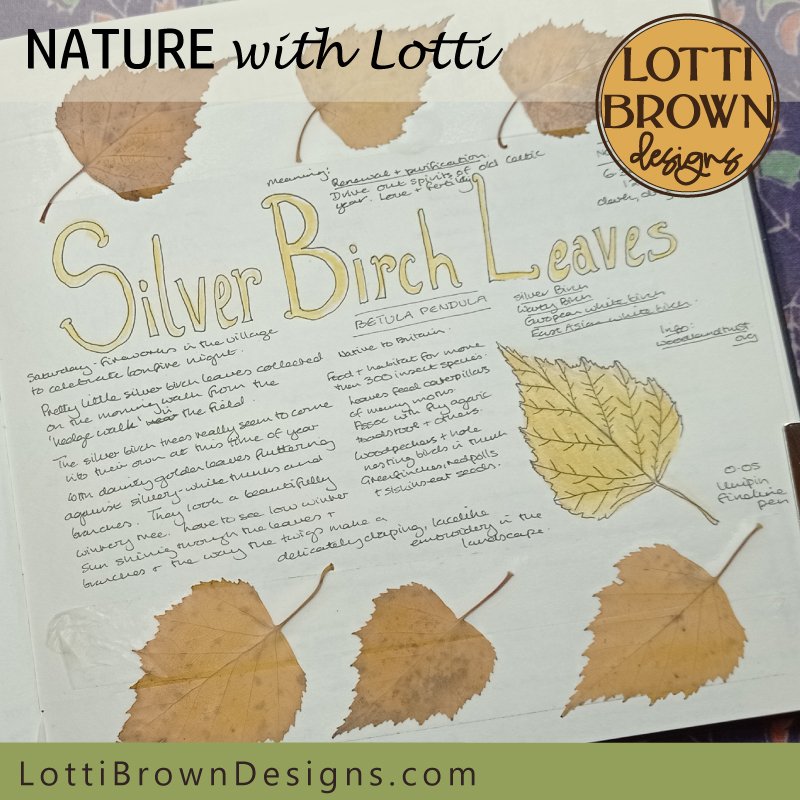 Collecting silver birch leaves in my nature journal
Collecting silver birch leaves in my nature journalI started my November nature journal with some pretty silver birch leaves that I'd collected. At this time of year, the silver birch looks so pretty with the bark shining silver-white and the tiny leaves dancing like gold pennies.
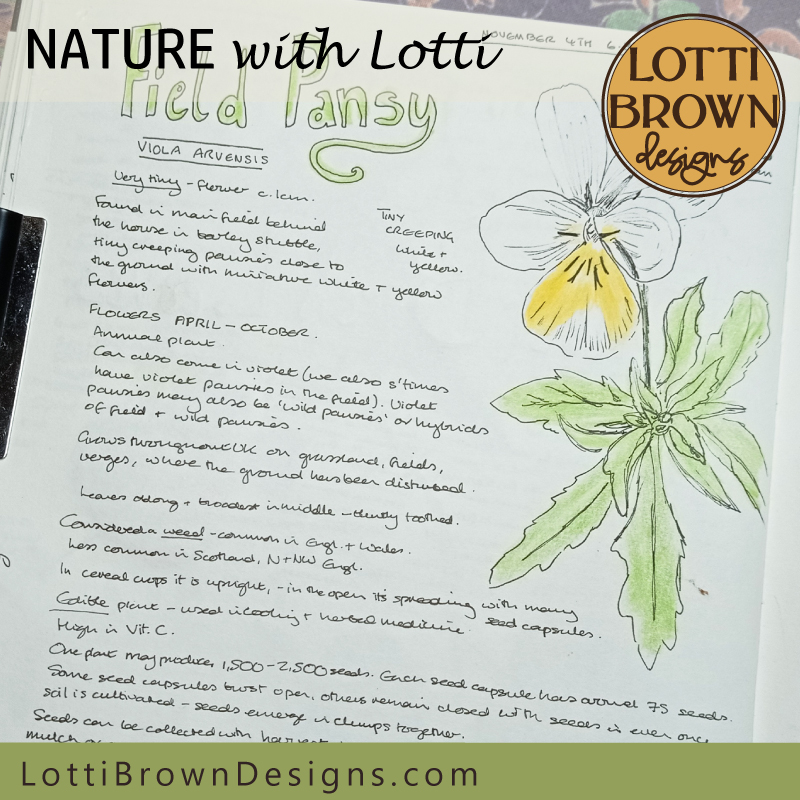 Field pansy
Field pansyWith the summer's crop harvested and nature starting to take over from the stubble in the field, there are tiny flowers to be discovered. One of these is the miniature white and yellow Field Pansy (drawn enlarged in the image above). It's very sweet and pretty but is widely considered a weed. You can maybe understand why when you discover that one plant can produce over 2,000 seeds!
Looking similar, but distinct, I also found the Black Nightshade plant creeping through the stubble (see the image below). Although the flower is white with a yellow centre, the berries turn black when ripe. Not to be confused with Deadly Nightshade, it is still considered poisonous, containing the alkaloid solanine, and has been associated with witches, the devil, death, and/or magic. However, in some cultures some parts of the plant are eaten.
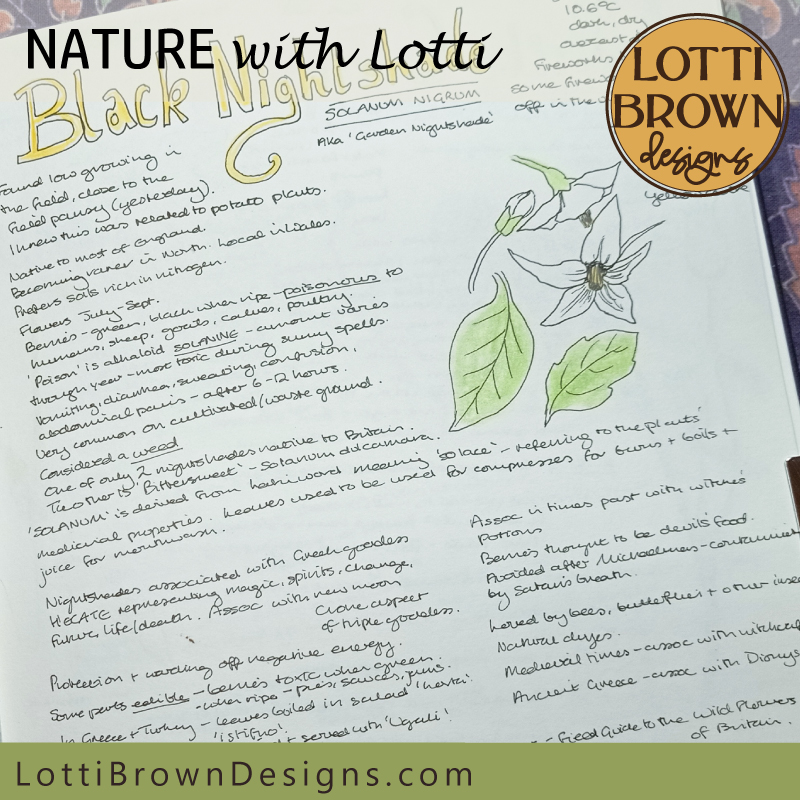 Black nightshade
Black nightshade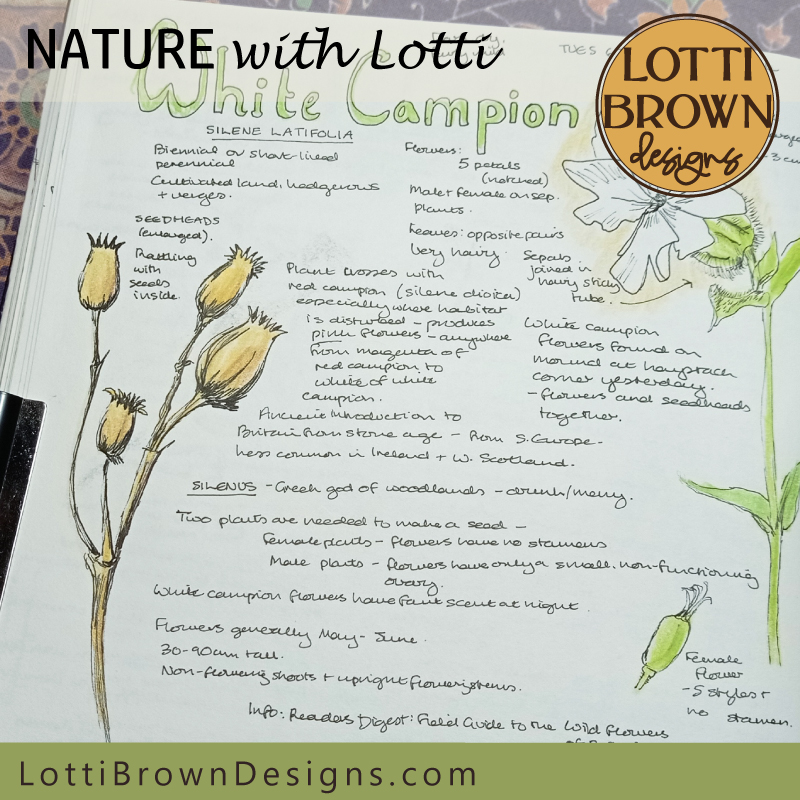 White Campion
White CampionOn my travels, I also discovered White Campion, both in flower and as a seedhead nearby. I was surprised to discover that White Campion has the male and female parts on separate plants. The seedheads are the female plant - I can hear the tiny seeds rattling around inside!
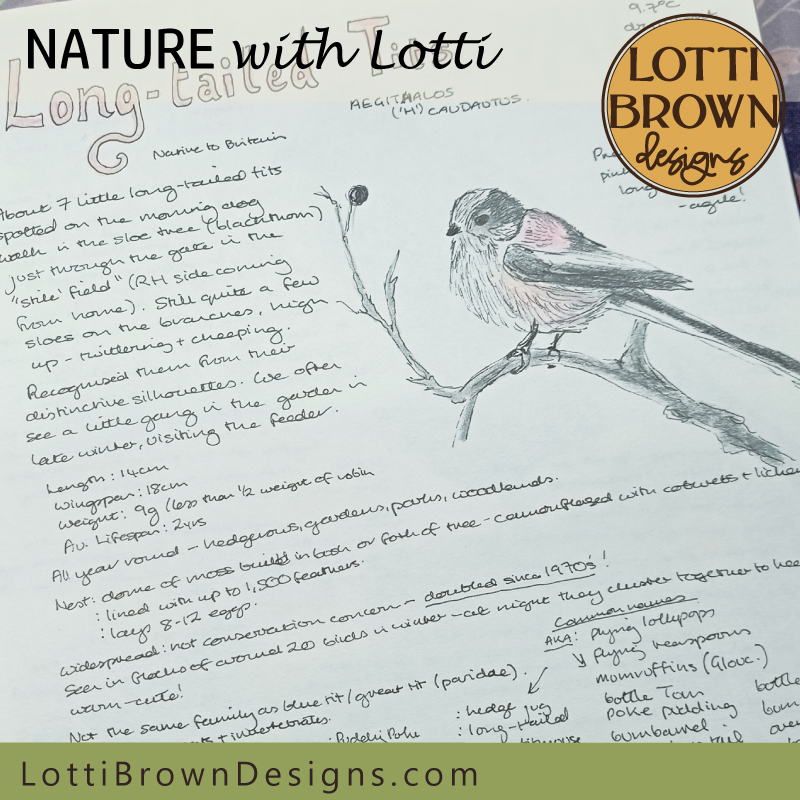
I was also very pleased to spot my first long-tailed tits of the winter. Sometimes, they come into our garden - but here I spotted them overhead in a blackthorn tree, presumably helping themselves to the black sloe berries. They're very distinctive, tiny with over-long tails and pretty pink, black, and white colouring. Some of their common names are very quaint and funny, such as poke puddings, bum barrels, mumruffins, and fuffits!
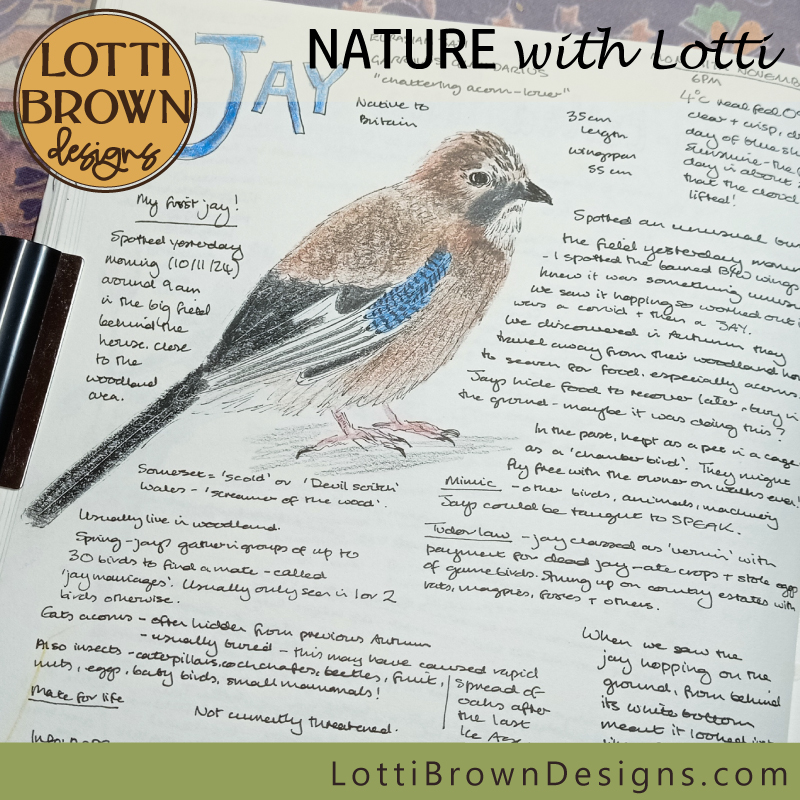 Jay nature journal page
Jay nature journal pageNext, is my first jay of the winter - and actually my first ever jay! I saw him on the ground in the field, close to trees - hop, hop, hopping. From behind, with his white bum fluff, he looked just like a rabbit at first, but his black and white barred wings gave him away. Although normally they keep to the trees and are difficult to spot, they can sometimes be seen in Autumn as they come further afield to forage and hide acorns. I did spot my jay right next to a big oak tree!
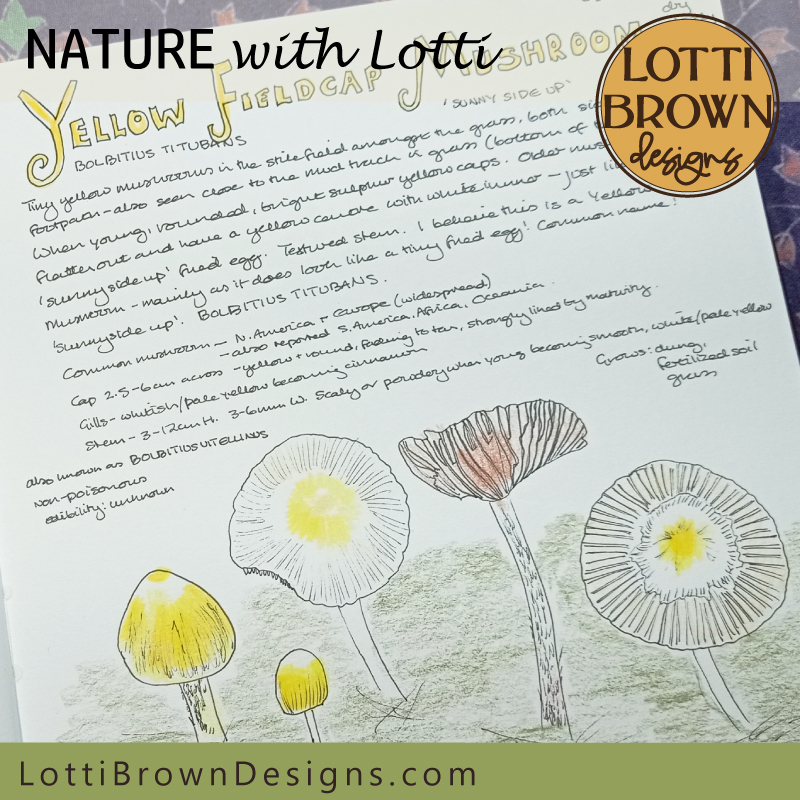 Yellow Fieldcap mushrooms nature journal page
Yellow Fieldcap mushrooms nature journal pageI love how since I started nature journal I've become much more observant when I'm going about my daily life and I was excited to spot these actually very bright yellow little mushrooms, which I'm sure I've never seen before. They start of little round buttons of bright sulphur yellow and end up looking like a fried egg. I do find fungi hard to identify but I think I got this one right when I saw that their common name is 'sunny side up' as they look just like a fried egg!
This is (I think) the Yellow Fieldcap mushroom (Bolbitus titubans). They are reportedly widespread in Europe and North America and have also been recorded in South America, Africa, and Oceania, so keep a look out for a little yellow mushroom where you are too. They're most often found in dung or fertilized soil and can also be found in grass, which is where I found both sets of specimens I found.
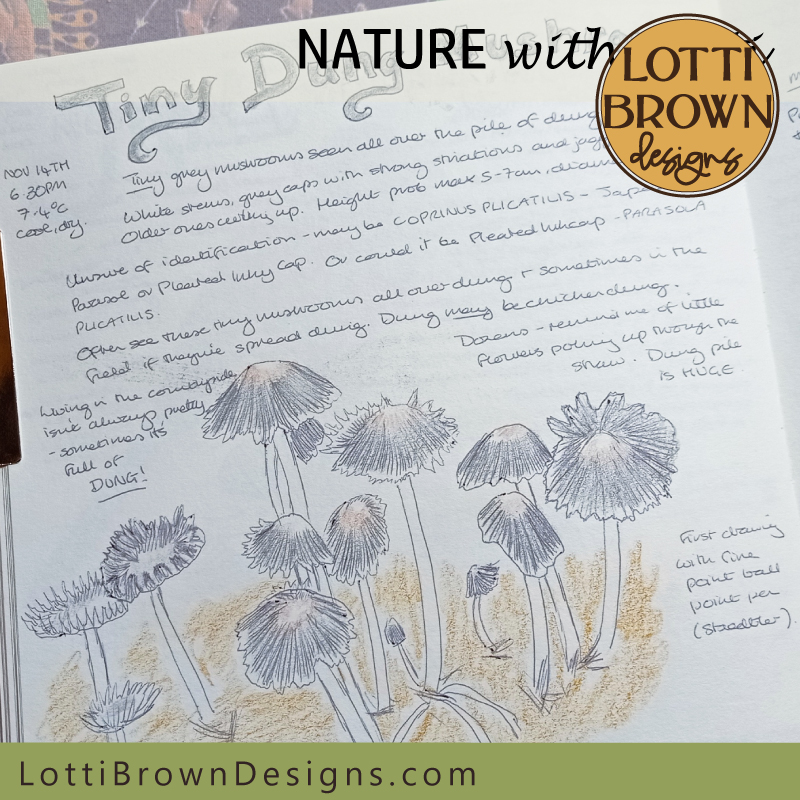 Tiny dung mushrooms nature journal page
Tiny dung mushrooms nature journal pageSome more fungi! I see this tiny little grey mushrooms all over the pile of dung in the field behind my house - they're quite pretty and dainty but it's a bit smelly to get a closer look! I'm unsure of their identification as I couldn't find anything that looked just the same.
But also on the dung, I found lovely Pied Wagtail birds (below) - these I always see hopping on and around the dung pile - I expect there's lots of little insects that they like to eat!
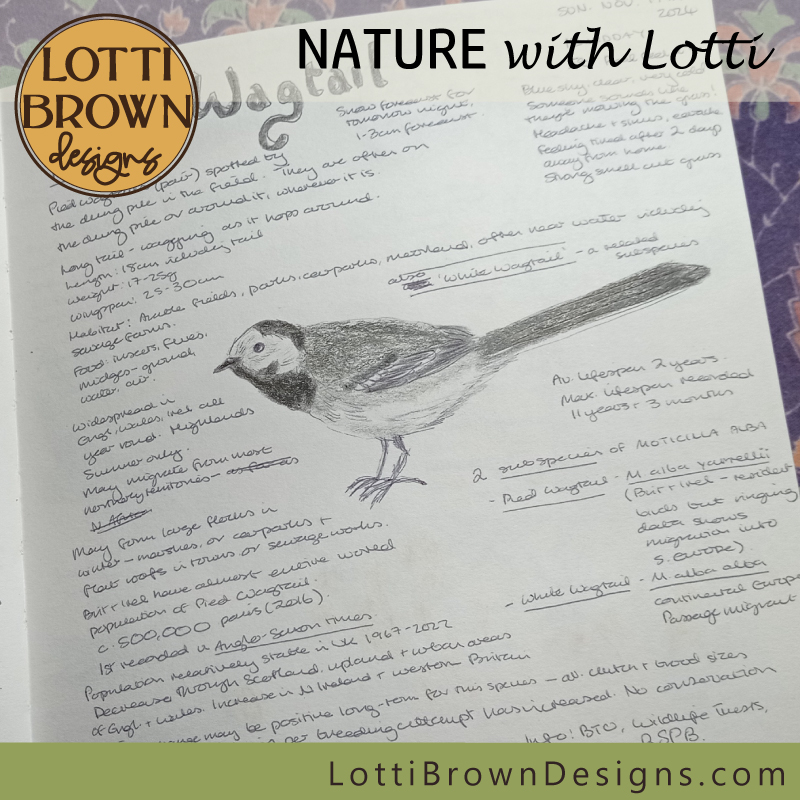 Pied wagtail birds
Pied wagtail birds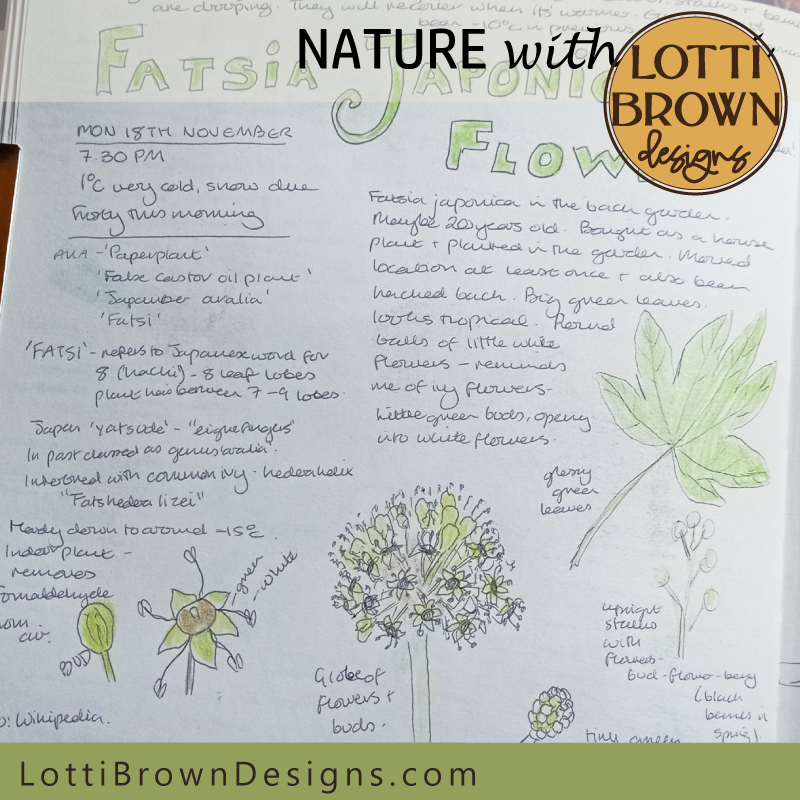 Fatsia Japonica flowers
Fatsia Japonica flowersI have a lovely big Fatsia Japonica plant at the bottom of my garden - and it just caught my eye with the tall stems filled with globes of tiny white flowers. It's an unusual time of the year for flowering, but flower it does with minute white blooms. It's an amazing plant with a tropical look but it's so hardy and has withstood countless harsh winters here in Yorkshire with no protection other than a sheltered spot in the garden.
Unfortunately, after I added it to my nature journal here, we had a very hard frost and although the plant itself is still in good health, the stems of flowers have wilted and faded. So I was pleased I just managed to include it in my journal in time!
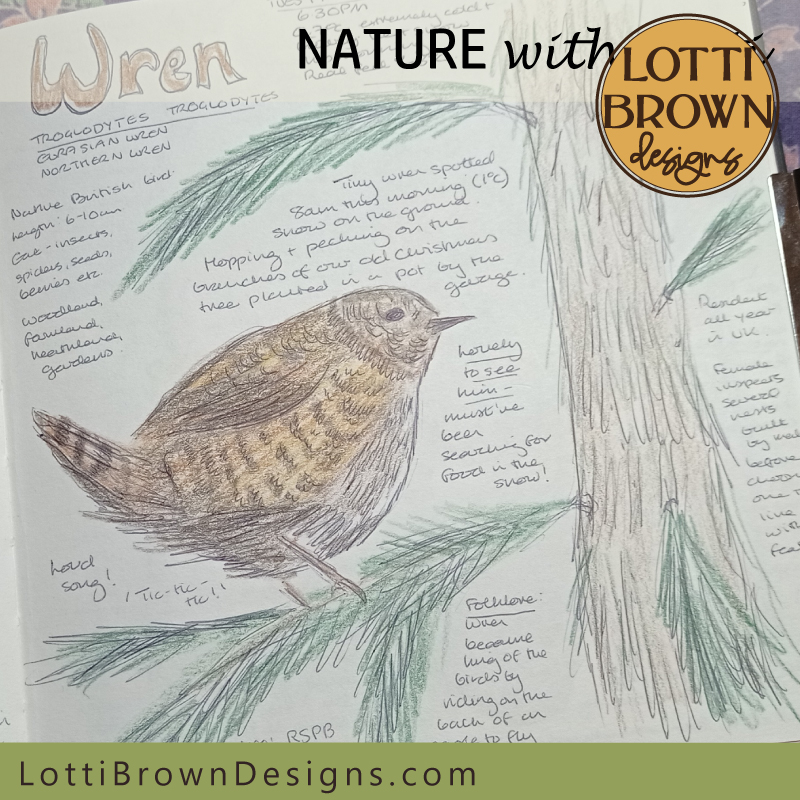 Wren in fir tree
Wren in fir treeAs the weather's dipped below freezing for several days at a time, I'm seeing more birds in the garden - one of my favourites is the wren who I haven't seen all summer. I saw him/her after a snowy morning, with the ground and plants still frozen, hopping up and down my old Christmas tree (it's been living in a pot for the last 20 or so years) and having a little peck at insects. Very happy to see my wren!
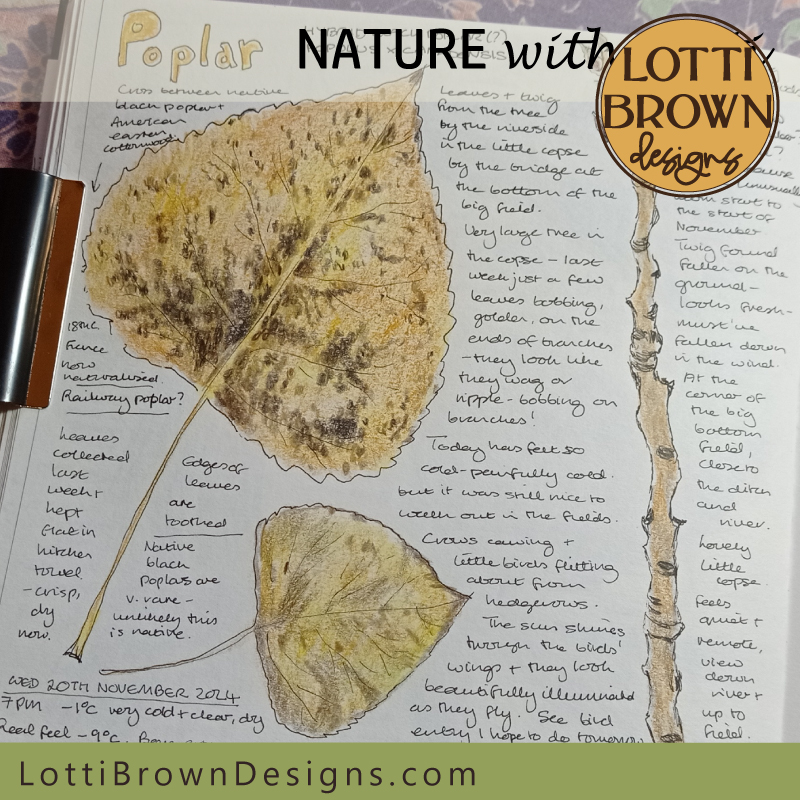 Poplar tree leaf and twig
Poplar tree leaf and twigThis page is about a poplar tree I found on one of my walks. I collected the leaves a week ago when they were yellow and crisp, still, and saved them in kitchen towel, pressed under a heavy book, as I wanted to be able to identify the tree. I think it's a Hybrid Black Poplar tree. I also this week found a long twig fallen from the same poplar tree which caught my eye as it had fresh-looking green and red pointed buds on it, which I thought was unusual for this time of year.
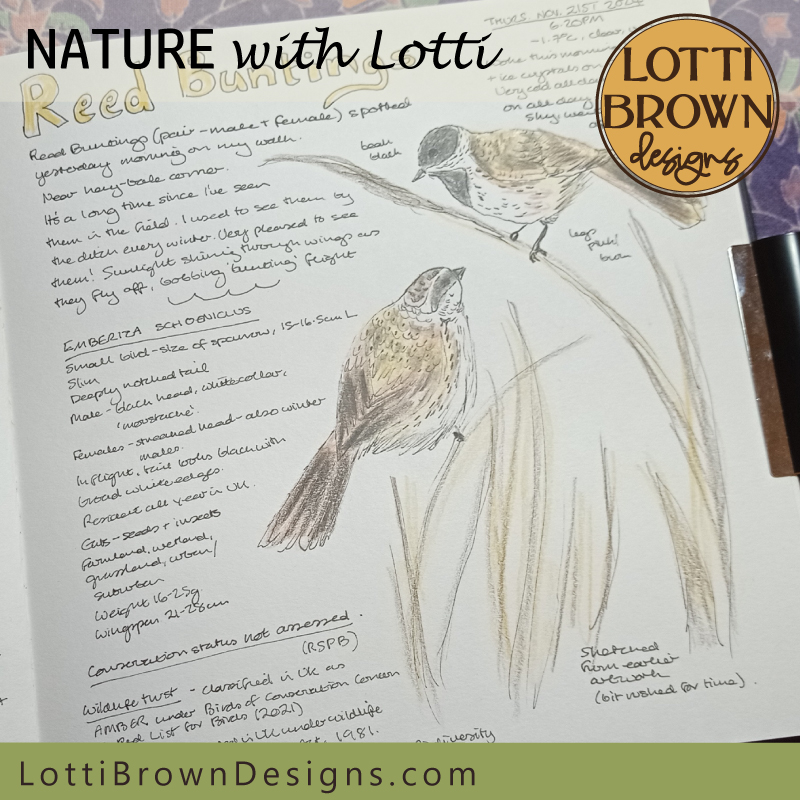 Reed Buntings
Reed BuntingsOne of my favourite wildlife 'spots' has been a pair of Reed Buntings, spotted perched on reeds alongside a ditch. I've seen Reed Buntings along the same ditch before, but not for several years, so I was very pleased to see these again. They fly in long bobs, which look like the line of a string of bunting hung out, so they're named as the buntings of the reeds.
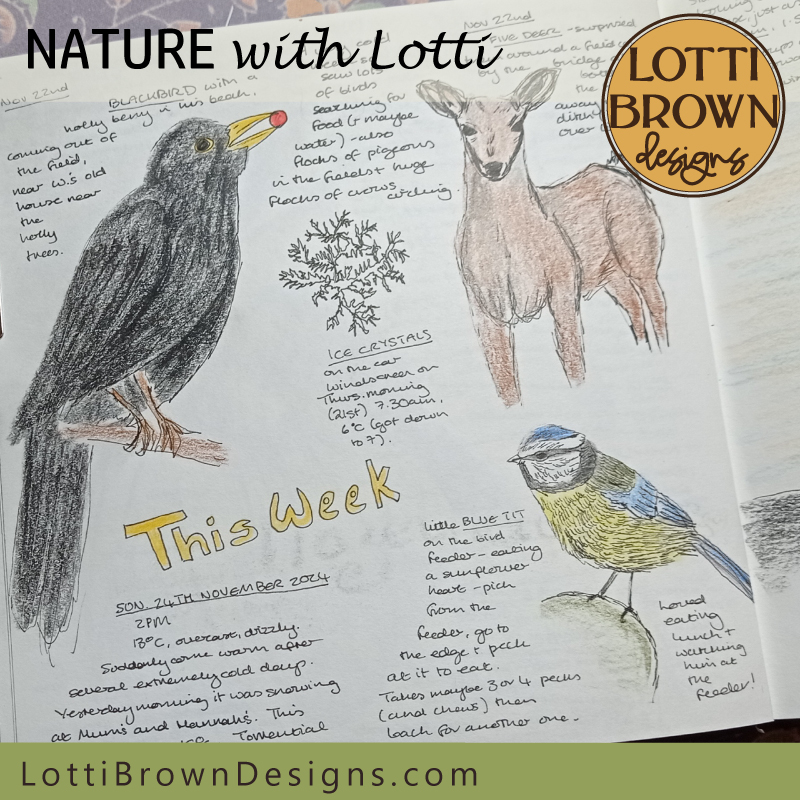 Weekly nature journal page
Weekly nature journal pageOne of the benefits of having such a cold week in later November, is that it's certainly brought the wildlife out to look for food, so I've spotted quite a few more birds and wildlife this week so I added a page for some of my favourite nature spottings...
So I included a little blue tit I watched on my bird feeder one lunchtime, a blackbird I spotted with a holly berry in his beak, five deer I happened upon on my walk and that were really close, and some gorgeous ice crystals on the car window at minus 6C.
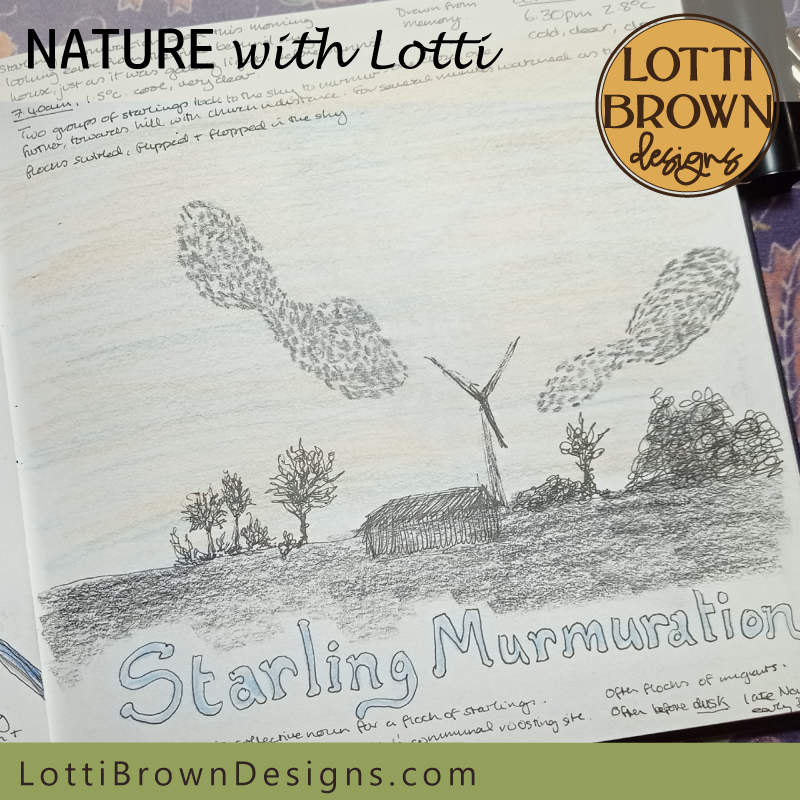 Starling murmuration nature journal page
Starling murmuration nature journal pageGetting up in the dark in winter isn't so much fun, but I was delighted to get to spot an early morning starling murmuration just before sunrise (drawn from memory). I think the fact that the sky was so clear was really helpful to spot them!
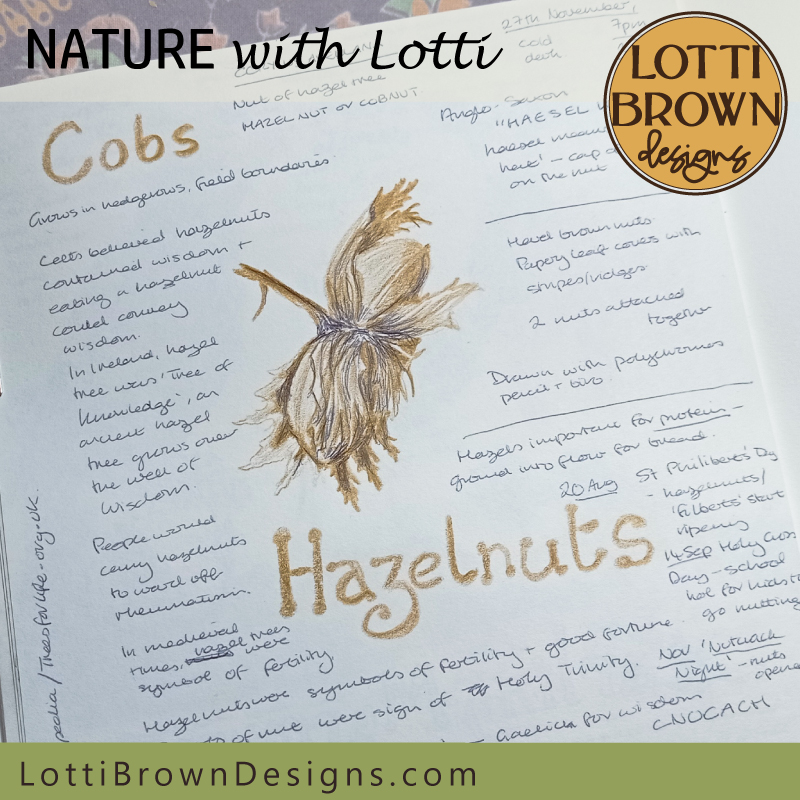 Hazelnuts
HazelnutsI found a cute little pair of hazelnuts to draw - and did a quick sketch in coloured pencil with additional shading in ballpoint pen. And I discovered that hazelnuts used to be considered symbols of luck and fertility. They were a staple food here in Britain in the past and mixed with flour for a more protein-filled bread. Hazelnuts were collected in September but not cracked open until November, on the intriguingly named 'Nutcrack Night'!
I hope you've enjoyed this trip through my November nature journal pages. The month started quite mild so there were a few flowers that I found to draw, which I was quite surprised about. Also fungi and tree leaves, which I would expect for November - and I was pleased to see more birds in the garden and field as the colder weather sets in and the leaves fall (so we can see the birds more easily too).
My favourite spots for the month are the jay, the wren, and the starling murmuration.
I wonder what I'll be able to spot in December. I worry for the next couple of months what I'll be able to find and if I'll be able to keep my nature journal going to the same extent, especially as my daily dog walks will now be in the dark for a while, but I will definitely be out and about seeing what catches my eye and what I could put in my nature journal, so let's see...
If I've inspired you to start your own nature journal too, you can get my free guide to getting started with your first nature journal here...
Also do take a look at all my info about nature journaling here (my main nature journal page). I do also have a short online nature journaling course to get you going, if you're wondering what to journal about or how to journal - I call it 'Imperfect Nature Journaling' as a reminder that nature journaling is something we do for us, for our own connection with nature and personal well-being, and we're free to do it in our own way - that's here...
Online Nature Journaling Course

If you'd like to explore nature journaling more, please consider joining me for my 'Imperfect Nature Journaling' online course - I've called it this to remind us to nature journal for the process of connecting with nature to feel good and not to put pressure on ourselves to create pretty pages which can quickly ruin the fun and the benefits...
It's a series of 20 lessons which are great exercises that you can do in your own nature journal to help you try out different ideas and techniques.
This will help you get the most out of your nature journaling sessions and understand what style of nature journaling is the best for you personally.
If this sounds like something you might like, you can find out more about the course here...
Want to keep in touch?
Sign up below for my free email newsletter...
My newsletter is usually sent out once a month (at the end of one month or the start of the following month) and you can unsubscribe any time...
Sign up below...!
Recent Articles
-
Willow Tree Symbolism and Celtic Willow Art
Apr 11, 25 05:43 AM
Explore willow tree symbolism and meaning - Celtic willow art and printed products... -
Wild Dog Rose Pattern & Products
Apr 07, 25 06:12 AM
Pretty dog rose pattern and products in a nostalgic heritage style recalling pretty hedgerows of flowers... -
British Robin Book Recommendations
Apr 04, 25 06:26 AM
My British Robin book reviews and recommendations - learn about Britain's favourite bird...
Follow me:
Share this page:


